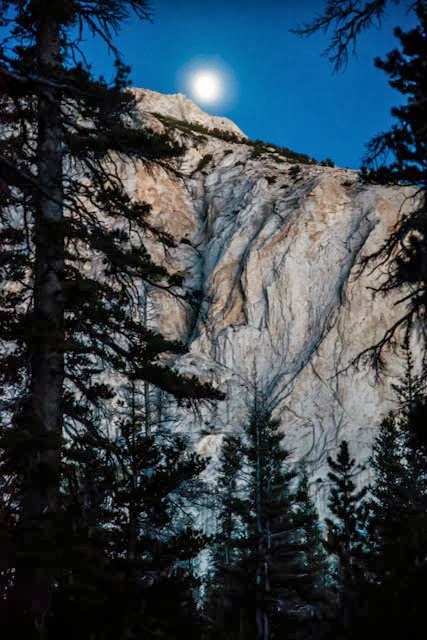 |
| The autumnal Tuolumne River near Parson's Lodge |
In mid-September 2013, as the Rim Fire raged just to the northwest, about a dozen researchers gathered
with friends and family where we were privileged to work
together four decades earlier. The place was Yosemite’s Tuolumne Meadows and
the research was surveying backcountry use and evaluating the impacts of
backpacking on Yosemite’s fragile subalpine ecosystem.
 |
| 26-year old Bob taking the pulse of a Yosemite bear in 1975 |
In 1975 I was a long-haired graduate assistant helping the
Park Service research and manage Yosemite’s black bears. The tent cabin I
shared with my fellow bear researchers was located in the same Tuolumne Meadows
“Bug Camp” that was the home base for the backcountry human impact researchers,
who were mostly college students who hiked and camped for most of the summer in
Yosemite’s backcountry.
 |
| Dan welcomes reunion participants |
Dan was the lead backcountry impact researcher in
the 1972-1975 study. As an undergraduate Dan initiated the project, hired his
young researchers (most of whom had never backpacked before), enrolled the Park
Service in the project and cobbled together funding and logistical support from
friends (including an essential Dodge Power Wagon). The result was Dan’s graduate thesis which helped establish the ecological carrying capacity of
Yosemite wilderness and led to the current wilderness permit system.
 |
| Tuolumne's magnificent Maybeck-designed and 1915-built Sierra Club Parson's Lodge |
Naturally, it was Dan who organized the 40th
Reunion at Tuolumne Meadow’s Parson’s Lodge. I was the only one of the bear researchers able to attend and I didn’t have a clear recollection
of any of the backcountry impact researchers who attended (they worked mostly
away from Bug Camp and we often worked at night and slept during the day). But
I and my wife felt very much at home and welcomed at the reunion and
we quickly made many new friends.
 |
| Dan and Jan reminisce and reflect on Yosemite wilderness research and management |
Dan invited Jan, emeritus Park Service researcher, who was
involved in the 1972-75 work and Mark, the current Wilderness Specialist who continues
managing impacts on Yosemite’s backcountry. Those who wished to make a
presentation shared how their careers and lives had unfolded since those
formative summers in Yosemite. My presentation was Yosemite’s Cathedral: Entering Sacred Wilderness.
 |
| Sunrise behind Cathedral Peak |
I was struck by four things: 1) the lasting value
of this pioneering wilderness impact study, 2) Dan’s generous mentoring and
support of his young students in the 1970s, 3) the wonderful personal and
public accomplishments his researchers have individually created with their
lives since their Yosemite work, and 4) how this group of talented people are a
creative bridge between important wilderness conservationists and artists of
the past and those just finding their voices today.
 |
| Obata's 1930 woodblock: Lake Basin in the High Sierra |
 |
| My 2008 rephotograph of Obata's painting position and view |
This intergenerational bridge includes reunion attendees who
worked with or knew as family friends the wilderness activist David Brower, photographers
Ansel Adams and Galen Rowell, and the artist Chiura Obata. Our common roots are
interwoven with U. C. Berkeley, the Sierra Club, saving Mono Lake and Yosemite.
I watched as Dan began to pass this wilderness preservation torch on to the
next generation in the form of mentoring a young backcountry ranger named Chris
who we met on our post-reunion backpack trip to Nelson Lake. Dan, whose mother
was Obata’s last student, is encouraging me to get the unnamed lake that Obata
painted in 1930 officially named Obata
Lake.
Here are some of the achievements of this extraordinary
gathering of Yosemite-inspired souls:
Anne, now a professor at Naropa Institute, has led western
pilgrims on month-long trips to and around the sacred Tibetan peak of Kailas.
Joe, an accomplished photographer and former student of Ansel Adams. Ellen, a
professor at San Diego State, helps medical students learn compassion and
patience by working with horses. Margo devised a process for building consensus
among polarized stakeholders of Alaskan wilderness. Heidi, a professor at
Whitman College, conducts bee research in the U.S. and Sweden. Steve helped start
the U.S. Environmental Protection Agency and received a Nobel Prize for his
work on protecting the Ozone Layer. Avis was an early designer and promoter of organic gardening.
And Kathy, who successfully got the polar bear listed as endangered due to
Global Warming, the first species to be so listed.

My most lasting impression of this reunion is how we share
a special love for Yosemite and Tuolumne Meadows and how we value our formative time
spent here. A century earlier this extraordinary landscape shaped a young John Muir and led to
the creation of national parks around the world. This unique spiritual landscape
continues to bless the world through the healing it works
in the hearts and lives of generations--past, present and future.


























































